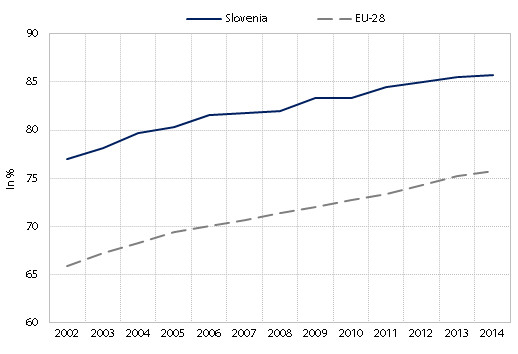SOCIAL WELL-BEING - Education
The indicator Share of the population with at least secondary education measures the educational level of adult population. The indicator covers upper secondary and tertiary education and is important for well-being because persons with at least secondary education are on average more likely to be employed and have higher income and less likely to be unemployed and at-risk-of poverty and social exclusion. Growth of the indicator has a positive impact on well-being.
Figure: Share of the population with at least secondary education, Slovenia and the EU, 2002−2014 (in %)

Source of data: SURS, Eurostat.
In 2013, 85.5% of the population in Slovenia aged 25−64 (in 2014 0.2 percentage points more) had at least secondary education. The share has been constantly increasing; in the 2000–2014 period it went up by as much as 10.3 percentage points. Compared to the EU average (76% in 2014), the share in Slovenia is much higher. The high share is mostly the result of a well-developed public education network, high participation of young people in education, low share of early school leavers and favourable financial possibilities for education.
Results of supplementary indicators show:
The share of the population aged 25–64 with tertiary education is growing rapidly. It has grown from 15.9% in 2000 to 27.9% in 2013 and 28.6% in 2014 and is now very close to the EU average (29.3%).
The increase in the number of people with tertiary education stems from the rapid growth of the number of young people with tertiary education. In the age group 30–34 40.1% of people had tertiary education in 2013; in 2014 the share was 0.9 percentage points higher. Growth is the consequence of high participation of young people aged 20−24 in tertiary education, which stems from the preservation of free studies, favourable ratio between the number of available places and applications, and the government scholarship policy. The share of young people with tertiary education in Slovenia is much higher than in the EU overall (37.9%); it exceeds the EU 2020 Strategy target of 40% of young people with tertiary education.
In the total number of tertiary education graduates in 2013, graduates of maths, science and technology represented 25.7%. The share has been increasing relatively rapidly since 2006. In the 2008–2013 period it grew by 8.1 percentage points. Since 2011 the share of these graduates in Slovenia has been higher than in the EU overall (2012: 22.8%).
Average achievements of 15-year-olds at all three domains of literacy (PISA) worsened between 2006 and 2009; in 2012 they were at about the same level as in 2009.
The share of young early school leavers was in 2013 3.9% and the lowest since 2001; in 2014 it was at the long-term average of 4.4%. As in the previous years, the share of young early school leavers in Slovenia is much lower than the EU average (2013: 11.9%).
Participation of children in pre-school education from age 4 to entering compulsory education had been gradually rising until 2012, when it was the highest in the past decade (90.9%). In 2013 and 2014 it declined slightly to 89.4%. In Slovenia participation of children in pre-school education is lower than the EU average (2012: 93.9%).
Participation of adults in lifelong learning has been rapidly declining since 2010, when it was 16.2%. In 2013, it declined to 12.4% and in 2014 by another 0.5 percentage points. In the 2008–2014 period participation of adults in lifelong learning declined by 2 percentage points (to 14.3%), but it is still above the EU average (2014: 10.7%).
The share of young people neither in employment nor in education was in 2013 the same as a year earlier (11.5%). In 2014 it increased by 0.5 percentage points and was the highest since 2002. However, the share in Slovenia is still much lower than in the EU overall (2014: 16.3%).
